In this example I will connect to a folder of shp files and go though the steps of connecting and displaying the features of those files. To start click on the Data -Add Data icon on the Map Task Pane, this opens up the data connect palette.
The format that you can connect to is listed on the left side of the palette. Click on the format you want to connect with. The options or methods of connections vary depending on what format of files you select on the left side of the palette. This example I am connecting to shp format so all that is displayed it the name and paths to those file(s) For the connection name call it what you want, but keep it simple and later when you create a legend for you map this connection name may end up being the title for that legend. (more on that later). For the source file or folder you have two options either a connection to a single file or to a folder of files. You can browse to the file or folder by clicking on the icons.
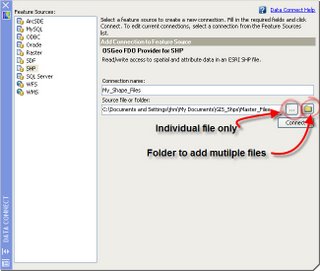
Once you select the folder/file click on the connect button.
The palette now displays the list of files in the folder or the single file if you selected only one file. This is where you select the file(s) to add to your map. You can select only the files you want if you are connecting to a folder. Place a check mark in the box to the file you want. Then click on the Add to Map button at the bottom of the palette.
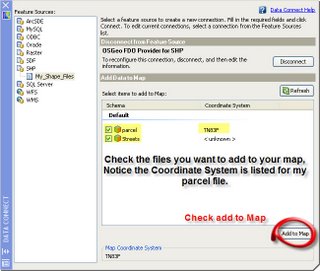
The next palette displayed allows you to perform a query on the data to add to the map, much like when you use the import command. You can query on location or by values of the feature data. Click the OK button.
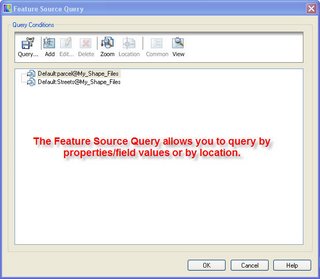
After a few seconds or longer depending on the size of the files and your workstation the features are displayed in the map.
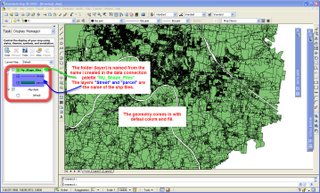
In the Map Task Pane in the Display Manager you will have what AutoDesk MAP is calling layers displayed. This is similar to the Table of Contents with the ESRI products or other GIS systems. Keep in mind this is only a name used in the display manger and should not be confused with the AutoDesk LAYERS that are a property of AutoCAD entities.
So now that you are connected and have added the features data of another format you can change the way they are displayed by using the Style Editor for that layer. To change the way a feature layer is displayed, select the layer in the Display Manger, right click and select Edit Display Style. This opens up the style editor palette that allows you to edit how those features are to be displayed and at what scales.
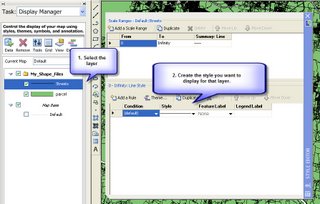
The top half of the palette controls the scale display and the bottom half controls the style. The editor allows you to display the features with different styles at different scales at zoom levels. With this example I will set a few styles for my parcels and street layers.
First we change the color of the street layer to RED, then change the pattern of the parcels layer. To edit the style used, click on the swatch(hatch) or line under the style column.
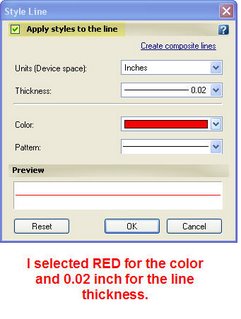
This opens a palette to allow you to select the color, line type and etc. for that style. Make sure you check the Apply style to the line check box at the top of the palette.
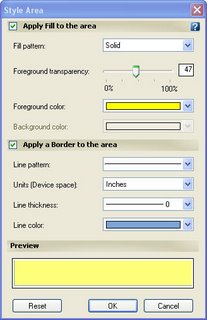
For the parcel layer, which is a polygon layer you can select the fill pattern along with a border to display and transparency for the foreground fill.
Now that we styled the map features take a look at what I have displayed.
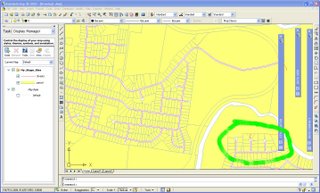
Notice that I have a street centerline that does not match up with the parcels in the area circled in green. The next posting I will go over some ways to edit that and make the corrections with out having to import, edit in Map, and export it back to the shp file format. You can edit and correct everything right in the data connect mode. So check back in a few days and hopefully I will have a few tips on using these features in Map 3D R
4 comments:
I'm sure you know this already, but may be worth posting that the transparency for these layers, while they show on screen, do not print.
A few people have stated they were able to plot with the transparency but more claim they can not. Maybe the next version will allow it to work for all.
Hey Murph I have a question for you about map clean. I have a grid system that im trying to make so we can assign map locations to customers in Esri. I have a key grid say 3242A then grids 1-100 then inside grids is sub grids 1-100 then inside sub grids is detail grids 1-100. I think by the time i get down to the detail gird we are at about 28 ft. I object data attached to all theses polygons showing what grid number each polygon is. Then i have this tool in Esri from http://www.spatialecology.com/htools/tooldesc.php
the one im using is called the Intersect Point Tool which lets me add fields of data to the end of my cust file depending on which polygon they are in. Finished product will be over 60,000 customers map location updated without me typing anything. Ok now that you know what im doing here is the question! When building this grid in tx83-ncf in Map 07 I have a lot of slivers and polygons nodes not matching up. What can I use in AutoCAD or Esri to fix this? If I can get one grid done I can copy and rubbersheet it to make the other grids I need. I am sorry for the long question but I figure if you know the story you might be able to help me out. I have very little knowledge of the mapclean tools in Map and being such a cad guy im jus not aware of the tools that might do this in ESRI.
Murph,
Congratulations with this topic! I'm looking forward to the next chapter about checking out features. What can you do with them? For me, it is hard to understand why Autodesk made it so hard to understand. But we won't give up!
Bart Belgium
Post a Comment